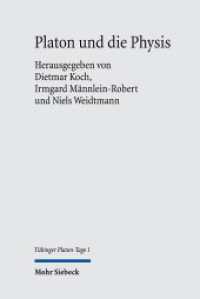Full Description
Lao She's Teahouse and Its Two English TranslationsDrama Translation with Systemic Functional Linguistics provides an in-depth application of Systemic Functional Linguistics (SFL) to the study of Chinese drama translation, and theoretically explores the interface between SFL and drama translation. Investigating two English translations of the Chinese drama, Teahouse ( Cha Guan in Chinese) by Lao She, and translated by John Howard-Gibbon and Ying Ruocheng respectively, Bo Wang and Yuanyi Ma apply Systemic Functional Linguistics to point out the choices that translators have to make in translation. This book is of interest to graduates and researchers of Chinese translation and discourse studies.
Contents
ContentsForewordList of FiguresList of TablesAbbreviations and SymbolsAbbreviations for Interlinear GlossingAcknowledgementsPrefaceChapter 1 Mapping and Approaching Systemic Functional Linguistics and Translation1.1 Systemic Functional Linguistics and Translation1.1.1 Early Studies before the 1970s1.1.2 Studies from the 1970s to the Millennium1.1.3 Studies after the Millennium1.2 Three Kinds of Text in Lao She's Teahouse1.3 Analytical Framework and Data SizeChapter 2 Re-enacting Interpersonal Meaning in Dramatic Dialogue2.1 A Description of Mood in Systemic Functional Terms2.2 Analysis of Mood in Dramatic Dialogue2.2.1 A Quantitative Profile of Mood Distribution in Dramatic Dialogue2.2.2 Mood Analysis of Pock-Mark Liu's Lines2.2.3 Mood Analysis of Wang Lifa's Lines2.2.4 Mood Analysis of Master Chang's Lines2.2.5 Mood Analysis of Qin Zhongyi's Lines2.2.6 Mood Analysis of Kang Liu's Lines2.2.7 Mood Analysis of Master Song's Lines2.2.8 Mood Analysis of Eunuch Pang's Lines2.2.9 Mood Analysis of Tang the Oracle's Lines2.2.10 Mood Analysis of Erdez's Lines2.2.11 Mood Analysis of Song Enz and Wu Xiangz's Lines2.2.12 Mood Analysis of Li San's Lines2.2.13 Analysis of Moodtags2.3 Mood Shift in Dramatic Dialogue2.4 SummaryChapter 3 Re-presenting Textual Meaning in Dramatic Monologue3.1 A Description of Theme in Systemic Functional Terms3.2 Analysis of Theme in Dramatic Monologue3.2.1 Analysis of Textual Theme in Dramatic Monologue3.2.2 Analysis of Interpersonal Theme in Dramatic Monologue3.2.3 Analysis of Topical Theme in Dramatic Monologue3.3 Theme Shift in Dramatic Monologue3.3.1 Theme Addition in Dramatic Monologue3.3.2 Theme Omission in Dramatic Monologue3.3.3 Theme Substitution in Dramatic Monologue3.4 SummaryChapter 4 Re-construing Logical Meaning in Stage Direction4.1 A Description of Taxis and Logico-semantic Type in Systemic Functional Terms4.2 Analysis of Taxis and Logico-semantic Type in Stage Direction4.3 Tactic and Logico-semantic Type Shift in Stage Direction4.3.1 Tactic Shift in Stage Direction4.3.2 Logico-semantic Type Shift in Stage Direction4.4 SummaryChapter 5 Analyzing Field, Tenor, and Mode: Perspectives from Context5.1 The Three Contextual Parameters in Systemic Functional Linguistics5.2 Contextual Analysis of Dramatic Dialogue5.2.1 Field of Dramatic Dialogue5.2.2 Tenor of Dramatic Dialogue5.2.2.1 Tenor between the Playwright/Translators and the Readers5.2.2.2 Tenor between Characters in the Play5.2.3 Mode of Dramatic Dialogue5.3 Contextual Analysis of Dramatic Monologue5.3.1 Field of Dramatic Monologue5.3.2 Tenor of Dramatic Monologue5.3.3 Mode of Dramatic Monologue5.4 Contextual Analysis of Stage Direction5.4.1 Field of Stage Direction5.4.2 Tenor of Stage Direction5.4.3 Mode of Stage DirectionChapter 6 Conclusion: Towards a Systemic Functional Account of Drama Translation6.1 Application of the Theoretical Framework in this Book6.2 Significance of the Study6.3 Some Thoughts for Future WorkReferencesIndex








